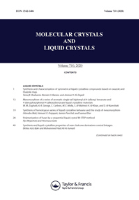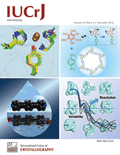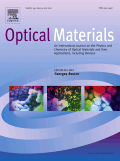
MOLECULAR CRYSTALS AND LIQUID CRYSTALS
Scope & Guideline
Exploring the Intricacies of Molecular Structures
Introduction
Aims and Scopes
- Molecular Crystallization and Structure Analysis:
This area encompasses the synthesis and characterization of molecular crystals, including the use of techniques such as X-ray diffraction and DFT calculations to analyze their structures and properties. - Liquid Crystal Chemistry and Physics:
Research in this domain focuses on the fundamental properties of liquid crystals, including phase transitions, electro-optical characteristics, and the impact of molecular structure on liquid crystalline behavior. - Nanomaterials and Hybrid Systems:
The journal highlights studies on nanomaterials and their integration with liquid crystals or polymers, exploring applications in electronics, photonics, and sensing. - Optical and Electronic Applications:
Papers often investigate the use of molecular crystals and liquid crystals in optical devices, including OLEDs, sensors, and photonic devices, emphasizing their functional properties and performance. - Thermal and Mechanical Properties:
This scope includes the study of thermal stability, conductivity, and mechanical properties of liquid crystalline materials and their composites, which is crucial for practical applications.
Trending and Emerging
- Sustainable and Green Chemistry:
There is an increasing trend toward the synthesis of eco-friendly materials and processes, highlighting the importance of sustainability in the development of new liquid crystalline and polymeric materials. - Smart and Responsive Materials:
Research is trending towards materials that respond dynamically to external stimuli, such as light, temperature, and electric fields, indicating a shift towards applications in smart devices and sensors. - Hybrid Organic-Inorganic Systems:
Emerging studies are increasingly focused on hybrid materials that combine organic and inorganic components, particularly for applications in photovoltaics and catalysis. - Advanced Photonic Applications:
The journal is witnessing a rise in research related to advanced photonic applications, including the development of liquid crystal-based devices for optical communication and information processing. - Nanotechnology in Liquid Crystals:
There is a notable increase in studies investigating the incorporation of nanomaterials into liquid crystal systems, enhancing their properties and expanding their application potential.
Declining or Waning
- Classical Liquid Crystal Theories:
Research focusing solely on classical theories of liquid crystals appears to be waning, as modern studies increasingly incorporate advanced computational techniques and novel materials. - Basic Studies of Simple Liquid Crystals:
There is a noticeable decline in publications centered around basic studies of conventional liquid crystals, with a shift towards more complex systems and multifunctional materials. - Traditional Organic Light Emitting Diodes (OLEDs):
While OLED research continues, there is a waning interest in traditional organic materials, with a growing focus on hybrid systems and new materials that enhance efficiency and stability.
Similar Journals

Liquid Crystals Today
Navigating the Dynamic World of Liquid CrystalsLiquid Crystals Today, published by Taylor & Francis Ltd, is an essential platform for researchers and professionals focusing on the fascinating field of liquid crystals. With an ISSN of 1358-314X and an E-ISSN of 1464-5181, this journal covers significant advancements in areas such as Condensed Matter Physics, Inorganic Chemistry, and Materials Chemistry, reflected in its recent classification within the Q3 quartile across these categories. Established in 1991 and with a rich history of disseminating impactful research, the journal provides critical insights and discussions pertinent to the scientific community. Although it does not follow an open-access model, its rigorous peer-review process ensures high-quality publications that contribute to the body of knowledge in liquid crystals. Researchers looking to stay updated in this dynamic field will find Liquid Crystals Today an invaluable resource.

IUCrJ
Catalyzing Discoveries in Biochemistry and Materials ScienceIUCrJ, published by the International Union of Crystallography, is a leading open-access journal dedicated to advancing knowledge in the fields of Biochemistry, Chemistry, Condensed Matter Physics, and Materials Science. Since its inception in 2014, IUCrJ has quickly established itself as a prestigious platform for high-quality research, achieving a remarkable record as a Q1 journal across its categories in 2023. With an increasing impact in the scientific community, evidenced by impressive Scopus rankings, IUCrJ offers unparalleled access to groundbreaking discoveries and methodologies that contribute to the understanding and application of crystallography in various disciplines. The journal’s commitment to open access ensures that research is readily available to a global audience, fostering collaboration and innovation in the scientific community. IUCrJ is an essential resource for researchers, professionals, and students aiming to stay at the forefront of crystallographic research and its interdisciplinary applications.

OPTICAL MATERIALS
Bridging Disciplines with Optical ResearchOPTICAL MATERIALS is a peer-reviewed journal published by Elsevier, focusing on the intricate field of optical materials within various scientific domains including atomic and molecular physics, electronic engineering, and chemistry. With an impact factor indicative of its relevance, it ranks in the Q2 category across multiple areas such as Electrical and Electronic Engineering, and Inorganic Chemistry, highlighting its critical position in advancing research and innovation. Established in 1992 and continuing its contribution until 2024, this journal serves as a vital resource for researchers and professionals aiming to disseminate significant findings in material sciences, particularly those related to optical properties and applications. While it does not offer open access, the journal remains essential for academia and industry alike, ensuring the continued exchange of valuable knowledge in this rapidly evolving field.

Nanophotonics
Connecting Researchers in the Realm of LightNanophotonics, published by WALTER DE GRUYTER GMBH, is a premier open access journal dedicated to advancing the field of nanophotonics, encompassing cutting-edge research in atomic and molecular physics, optics, biotechnology, and electronic engineering. With a significant impact factor and a notable presence in the top quartile rankings (Q1) across multiple categories, including electrical and electronic engineering, this journal serves as a critical resource for researchers and professionals aiming to explore the latest developments in the manipulation of light at the nanoscale. Since its inception in 2012, Nanophotonics has been an influential platform for disseminating innovative ideas and breakthroughs, offering unrestricted access to its content, thus fostering a collaborative environment conducive to scientific discovery. Located in Berlin, Germany, and with a commitment to promoting the highest standard of scholarly excellence, Nanophotonics continues to shape the future of optical materials and technology, inviting contributions from both established experts and emerging scholars.

CRYSTAL RESEARCH AND TECHNOLOGY
Illuminating the Path of Crystal TechnologyCRYSTAL RESEARCH AND TECHNOLOGY, published by WILEY-V C H VERLAG GMBH, is a distinguished journal in the fields of Chemistry, Condensed Matter Physics, and Materials Science, with over five decades of continuous publication from 1966 to 2024. With its ISSN 0232-1300 and E-ISSN 1521-4079, the journal serves as a crucial platform for disseminating significant research findings, theoretical advances, and technological innovations related to crystal growth, structure, and properties. Holding a Category Quartile ranking of Q3 in the 2023 assessments across its disciplines, CRYSTAL RESEARCH AND TECHNOLOGY is recognized for its contribution to the scientific community, making it an essential resource for researchers, professionals, and students alike. While this journal is not open access, its robust publishing framework ensures that high-quality peer-reviewed articles remain accessible to a global audience. The importance of this journal lies in its commitment to advancing knowledge and fostering collaborations in crystallography and related fields.

MATERIALS CHEMISTRY AND PHYSICS
Advancing Knowledge in Materials Chemistry and PhysicsMATERIALS CHEMISTRY AND PHYSICS is a leading peer-reviewed journal published by Elsevier Science SA, focusing on the intersection of materials science and condensed matter physics. With an esteemed impact factor and a distinguished reputation in its field, this journal holds a Q1 ranking in Condensed Matter Physics and a Q2 ranking in miscellaneous Materials Science categories as of 2023. Spanning over three decades since its inception in 1983, it provides a vital platform for researchers, professionals, and students to disseminate cutting-edge findings and innovations in materials characterization, properties, and applications. The journal is indexed in Scopus, boasting impressive rankings that reflect its commitment to publishing high-quality research. Although it does not currently offer an Open Access option, it remains an essential resource for those seeking to stay at the forefront of materials chemistry and physics.

Advances in Condensed Matter Physics
Connecting Researchers with the Latest DiscoveriesAdvances in Condensed Matter Physics is a distinguished journal published by HINDAWI LTD, dedicated to the rapid dissemination of high-quality research in the field of condensed matter physics. Since its inception in 2008, this Open Access journal has facilitated wide accessibility to cutting-edge findings and theoretical advancements, with aims to foster collaboration and innovation within the scientific community. With an ISSN of 1687-8108 and an E-ISSN of 1687-8124, the journal covers an extensive range of topics, from quantum materials to nanotechnology, ensuring relevance and engagement across various sub-disciplines. As a testament to its impact in the field, it is ranked in the Q3 category for 2023 within Scopus and holds a position in the 34th percentile for physics and astronomy. The journal's continuous commitment to publishing significant exploratory research until 2024 makes it a pivotal resource for researchers, professionals, and students eager to stay on the leading edge of condensed matter physics advancements.

Crystals
Unlocking the Secrets of Crystalline MaterialsCrystals is a premier open-access journal, published by MDPI since 2011, that focuses on the multidisciplinary fields of chemical engineering, condensed matter physics, inorganic chemistry, and materials science. With its E-ISSN 2073-4352, the journal is headquartered in Switzerland, and actively contributes to the global scientific community by facilitating the dissemination of high-quality research. Ranking in the Q2 quartile across multiple categories, including Chemical Engineering (miscellaneous) and Materials Science (miscellaneous) for 2023, Crystals provides a platform for innovative studies that span from fundamental research to practical applications. The journal's commitment to open access ensures that groundbreaking findings are readily available to researchers, professionals, and students alike, fostering an environment of collaboration and knowledge sharing that is essential in advancing the scientific understanding of crystalline materials.

CRYSTALLOGRAPHY REPORTS
Connecting Researchers Through Crystallographic DiscoveriesCRYSTALLOGRAPHY REPORTS (ISSN: 1063-7745, E-ISSN: 1562-689X), published by PLEIADES PUBLISHING INC, is a pivotal journal in the fields of chemistry, condensed matter physics, and materials science. Established in 1996 and continuing through to 2024, it serves as a vital resource for researchers and professionals seeking to disseminate and engage with contemporary advancements in crystallography. While currently not classified as open access, the journal's rigorous peer-review process ensures the publication of high-quality research, making it a respected entity within the academic community. With a categorization in the Q4 quartile for its respective fields and notable Scopus rankings, CRYSTALLOGRAPHY REPORTS is committed to fostering an understanding of crystallographic techniques and their application across scientific disciplines. This journal is essential for those looking to stay abreast of the latest findings and methodologies in crystallography, providing a platform for impactful discussions and collaborations.

Chinese Journal of Liquid Crystals and Displays
Illuminating the Future of Liquid Crystals and DisplaysThe Chinese Journal of Liquid Crystals and Displays, published by SCIENCE PRESS, serves as a vital platform for researchers and professionals in the fields of electronic, optical, and magnetic materials as well as instrumentation and signal processing. With an ISSN of 1007-2780 and an E-ISSN of 2097-3217, this journal offers a unique perspective on advancements in liquid crystal technology and display innovations, reflecting the dynamic growth of this area of study since its convergence in 2015 through to 2024. Despite currently occupying a Q4 quartile ranking in multiple categories, researchers and industry practitioners will benefit from its publication of cutting-edge research, comprehensive reviews, and insightful discussions. Although not an open-access journal, this publication remains essential for those seeking to expand their knowledge and stay abreast of emerging trends in liquid crystals and display technologies, particularly from a Chinese perspective.